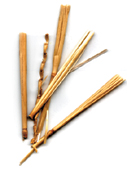

House of Straw
By Jennifer Kulier
When Jane Dillard '53 sits inside her home near the La Plata Mountains and Cortez, Colo., she feels as if she's wrapped in a warm embrace.
"It's kind of a cocoon-like feeling: quiet, comforting, safe," Dillard said. "It's so silent inside the house that I'm not even aware of the terrific winds outside. And I had to install a driveway alert device because I couldn't hear cars coming up my gravel drive."
Dillard lives in a house made of straw. Her nearly 2-foot thick straw bale walls, covered with several layers of stucco, provide a snug, efficient home that stays naturally cool in summer and warm in winter. Her guesthouse and garage were also built using straw bale construction, a building technique gaining in popularity and perfectly suited to the American Southwest. Dillard's love for the Southwest - its history and landscape - led her to settle here and build this unusual home after a life lived in conventional housing in West Texas.
"I have lived in the Southwest all my life, but about 15 years ago, I realized that I knew very little about it," said Dillard, who graduated from CC with a degree in geology. Dillard later spent two "thoroughly enjoyable" summers in CC's Southwest studies program, and now volunteers at Crow Canyon Archeological Center and hosts traveling archeologists and geologists at her home. Immersing oneself in study of the ancient cultures and environment of the Four Corners region has a way of making modern, "stick-built" construction look unnatural and out of place.
"I had heard about straw bale construction, and
the idea of recycling a local material that would otherwise be thrown
away appealed to me. I started to educate myself; visited straw bale homes
in Santa Fe and talked to builders. These homes have wonderful ambience
and they blend beautifully with their surroundings," Dillard said.

You may have seen a straw bale home and not even known it; bale walls
can be covered with nearly anything - white stucco, earthen plaster, clapboard
siding - to take on the look desired by the homeowner. Typically, straw
bale homes appear adobe-like with soft, red-brown hues and thick windowsills,
because most home-owners want a natural look.
People have built homes using straw, grass, or reed throughout history
because the materials are inexpensive, reliable, and easy to obtain. In
the United States, homesteaders in northern Nebraska in the 1880s used
baled hay and straw construction because of a shortage of trees and an
abundance of wild grasses. They found that the thick, insulating walls
kept their families comfortable year-round, withstanding Nebraska's wide
temperature swings and strong winds. The oldest existing bale structures
in the U.S. - built in Nebraska around 1900 - are still in use today.